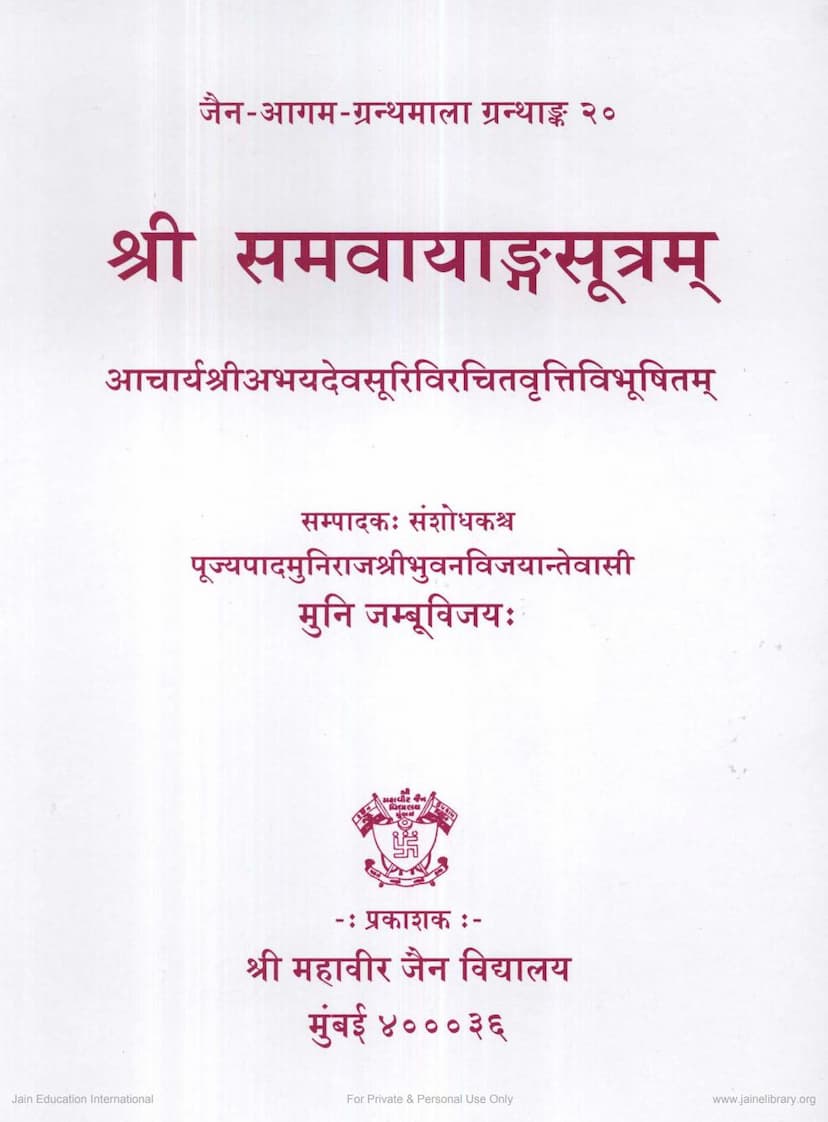Agam 04 Ang 04 Samvayanga Sutram Tika
Added to library: September 1, 2025

Summary
This Jain text, titled "Agam 04 Ang 04 Samvayanga Sutram Tika," is a significant work within the Jain tradition, specifically focusing on the Samavāyāṅga Sūtra, one of the Angas (core scriptures) of the Jain canon. The text is a commentary (Tika) on the Samavāyāṅga Sūtra, authored by the esteemed Acārya Śrī Abhayadevasūri. The critical edition presented here has been compiled and meticulously edited by Muni Jambūvijaya, a disciple of His Holiness Munirāja Śrī Bhuvanavijayajī Mahārāja. The publication is by Śrī Mahāvira Jaina Vidyalaya in Mumbai.
Key aspects and content highlighted in the provided pages:
- Title and Authorship: The book is identified as "Śrī Samavāyāṅgasūtram" with a commentary (Vr̥tti) by Acārya Śrī Abhayadevasūri. It is critically edited by Muni Jambūvijaya, disciple of Munirāja Śrī Bhuvanavijayajī.
- Publisher and Edition: Published by Śrī Mahāvira Jaina Vidyalaya, Mumbai. The first edition was released in Vir Samvat 2531 / Vikram Samvat 2061 / A.D. 2005, with 250 copies and a price of Rs. 450.
- Importance of Agamas: The publisher's note (Prakāśakīya Nivēdan) emphasizes the importance of the Āgama Sūtras as the collection of Lord Mahāvīrasvāmī's teachings. It states that a thorough study of these Āgamas reveals the pure form of Jainism and guides one towards the path of liberation.
- Role of Munirāja Śrī Puṇyavijaya: The text acknowledges the inspiration and initial work of Āgama Prabhākara Śrutaśīla-Vāridhi, the late Munirāja Pūjya Śrī Puṇyavijaya Mahārāja, who had previously edited the Prakrit commentary of Jyotishkaraṇḍaka Granth. His guidance was instrumental in the Āgama Granthamālā publication series.
- Muni Jambūvijaya's Contribution: Muni Jambūvijaya took on the significant task of completing the remaining Āgama publications after the passing of Śrī Puṇyavijaya Mahārāja. He is recognized for his critical editing of texts like the Sthānāṅga Sūtra and the Samavāyāṅga Sūtra, incorporating multiple ancient manuscripts and providing detailed annotations.
- Samavāyāṅga Sūtra's Content: The text is a critical edition of the Samavāyāṅga Sūtra, which is the fourth Anga of the Dvādaśāṅgī (Twelve Limbs of Jain scripture), compiled by Gaṇadhara Śrī Sudharma Swāmī. The Sūtra itself deals with various categories and enumerations of principles, substances, and concepts within Jain philosophy and practice. The commentary by Abhayadevasūri aims to clarify these complex topics.
- Commentary by Abhayadevasūri: Acārya Abhayadevasūri, a prominent scholar and commentator, is credited with composing the Vr̥tti (commentary) for the Samavāyāṅga Sūtra. His work is based on ancient palm-leaf manuscripts and paper manuscripts, reflecting a deep understanding of the subject.
- Critique of Textual Variations: The preface highlights the challenges of textual research, noting that variations (pāṭhabhēd) are natural due to the transmission of texts over centuries. Abhayadevasūri's commentary, as critically edited by Muni Jambūvijaya, aims to present the most authentic and clear readings based on a thorough comparison of manuscripts.
- Structure of the Book: The book includes various sections such as Publisher's Note, Jinaāgama Jayakārā (Gujarati Introduction), Prāstāvikam (Hindi), Āmukham (Sanskrit), "Two Words" (English), and a detailed life history of Acārya Abhayadevasūri. It also contains the subject index of the Samavāyāṅga Sūtra, the Sūtra itself, nine appendices, and illustrations.
- Dedication and Lineage: The publication is dedicated to various revered Jain spiritual leaders, indicating a lineage of Gurus and Acāryas, including Śrī Ṛṣabhadeva Bhagavān, Śrī Śāntinātha, Śrī Pārśvanātha, Ācārya Śrī Vijaya Siddhisūriśvara, Ācārya Śrī Vijaya Meghasūriśvara, and Munirāja Śrī Bhuvanavijaya Mahārāja. It also mentions the lineage of scholars and monks involved in the research and publication.
- Content of Samavāyāṅga: The text itself, as indicated by the "Samavāyāṅgasya Viṣayānukramaḥ" (Subject Index of Samavāyāṅga Sūtra), details the classification of various concepts, starting from "ekapadārtha" (one substance/principle) and progressing through two, three, and so on, up to much higher numbers. This suggests a systematic cataloging of Jain philosophical and cosmological concepts. It covers topics like the nature of soul, karma, heavens, hells, stars, planets, beings, and the structure of the universe, as well as the lives and teachings of Tīrthaṅkaras, Gaṇadharas, and other important figures.
- Appendices: The book includes several appendices providing valuable supplementary information, such as a glossary of specialized terms, an alphabetical list of verses with their meanings, comparative notes on textual variations, a list of source texts used, and a detailed biography of Acārya Abhayadevasūri. It also features illustrations, likely of Jain temples, deities, or cosmographical diagrams.
- Focus on Abhayadevasūri's Life: A substantial portion of the introductory material is dedicated to the life and biography of Ācārya Abhayadevasūri, highlighting his scholarly contributions, his spiritual lineage, and his efforts to ensure the purity and preservation of Jain scriptures. His commentary on the Navāṅgī (Nine Angas) is particularly mentioned.
- Language and Scholarship: The text is primarily in Sanskrit and Prakrit, reflecting the original languages of the Jain Āgamas and their commentaries. The meticulous scholarship involved in critically editing and publishing such ancient texts is evident.
- Thematic Focus: The Samavāyāṅga Sūtra, through its detailed categorizations and enumerations, provides a comprehensive framework for understanding Jain cosmology, philosophy, ethics, and the path to spiritual liberation. The commentary aims to make these intricate teachings accessible to contemporary scholars and practitioners.
In essence, this publication represents a significant academic and religious undertaking, making a crucial Jain scripture and its ancient commentary accessible to a wider audience through rigorous critical scholarship and dedicated editing. It underscores the enduring relevance of the Agamas and the continuous effort to preserve and study Jain knowledge.